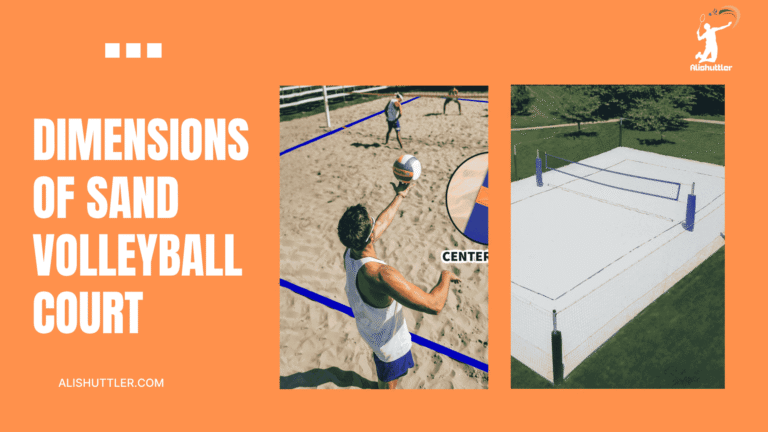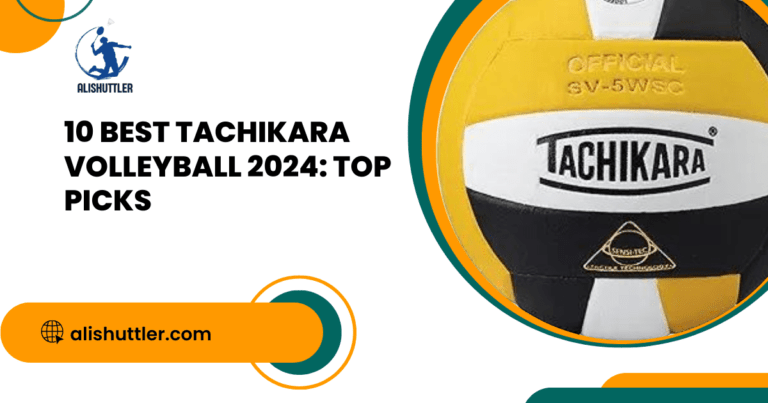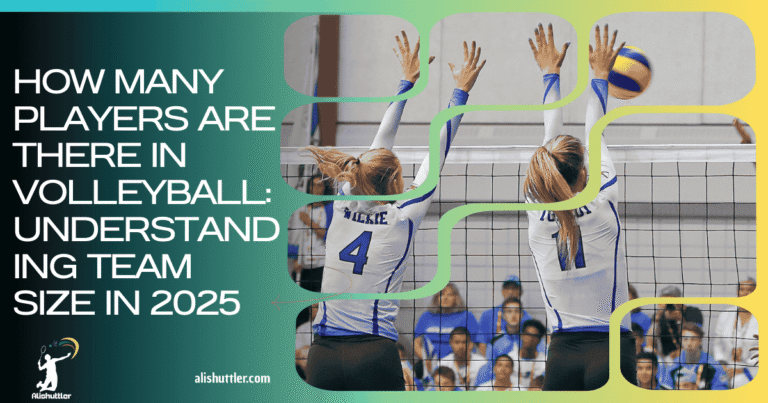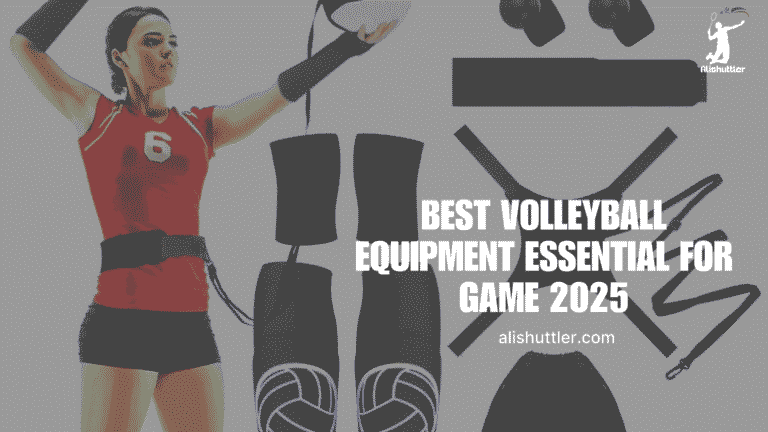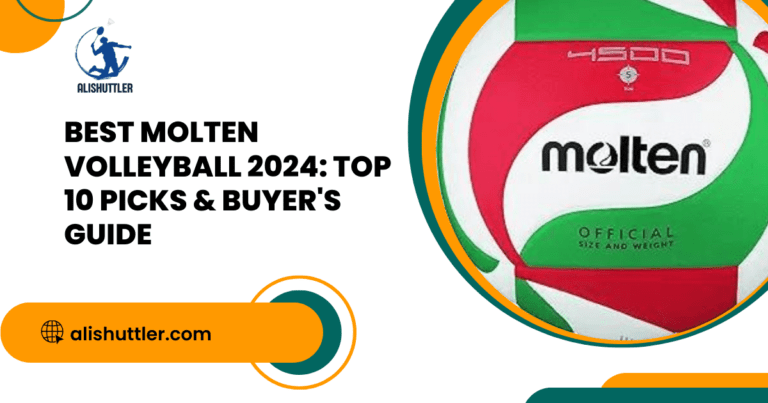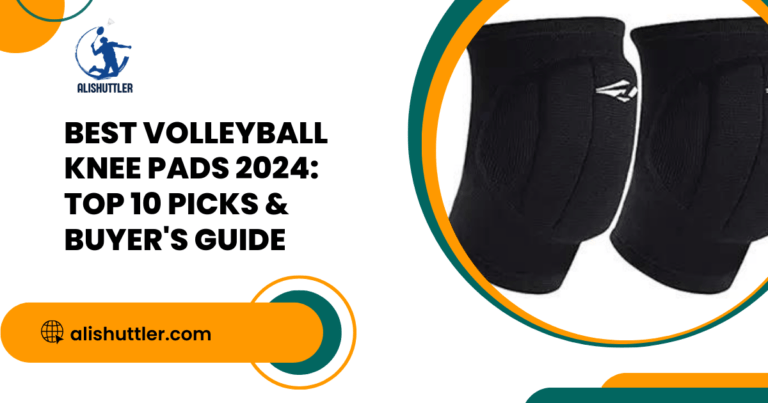Indoor volleyball courts are purpose-built facilities with regulated lighting, polished floors and marked boundaries. These courts protect games from rain, wind, or heat, so matches continue all year. Almost every sports center and school and gym has them for practice sessions, leagues and for a good time.
Nets remain at regulation heights, and floors, typically wood or a synthetic surface, minimize sliding. Next, the highlights and advantages of indoor courts are discussed.
Court Fundamentals
Indoor volleyball courts are constructed to rigid specifications to maintain fairness and safety of the game. These fundamentals ensure that players, coaches and fans worldwide experience the same court characteristics whether it’s a neighborhood gym or the world stage.
1. Dimensions
Regulation indoor courts measure 9m x 18m. Each half is 9 x 9 meters and has an attack line 3-meters back from the center line. The court — the playing area — averages 162 square meters. They’re standardized for international matches, so teams know they can expect the same space in each venue.
Outdoor courts, by comparison, are usually larger, with beach volleyball courts being approximately 8 x 16 meters and missing some of the indoor markings. Indoor courts require a minimum high ceiling of 7 meters (23 ft) above the playing surfaceto maintain safe play and accommodate high sets and serves.
To get a better picture, represent the court as a rectangle bisected by the net and each half containing three front-row and three back-row positions. A 3-meter attack line parallels the net on each side, assisting in marking off spiking zones and player rotations.
2. Layout
Key markings on the court are sidelines and baselines, each 60 feet long, and a center line dividing the court underneath the net. The attack line, or the “10-foot line,” lies 3 meters from the center line on each side, designating where back-row players can strike the ball.

To guide player movement and rotations, the court is divided into six numbered zones—three in front and three in back. This free zone encompasses the court and has to be minimum 3 meters wide, allowing players to jump and run after balls without the danger of hitting any obstacle.
For recreational, markings may be more lax, but competitive courts adhere to official standards to ensure fairness and safety. A basic diagram would depict the court as a rectangle, with the net running straight down the middle, attack lines 3 meters from the net, and all the boundary lines.
3. Net System
The volleyball net is set at 2.43 m for men and 2.24 m for women at the center. The net, which measures 36” x 32 feet, is bordered by vertical strips (called antennae) that mark the sidelines. These 2 inch-wide strips, for example, assist referees in judging whether or not a ball falls inside the court boundaries.
Net tension is key–too loose and the ball will dribble over, too tight and it could bounce back. Posts must be firm and stable, about 1 metre outside the sidelines for protection. Putting up a net involves securing the posts, measuring height with a tape, and pulling tension such that the net remains horizontal.
4. Clear Space
Free space around the court must be at least 3 meters on all sides. This prevents players from diving or running for the ball and bouncing into walls or equipment. Additional space enables secure play as the game accelerates.
Clear space involves maintaining freedom from low ceilings overhead, at least 7m recommended. In tournaments, staff have to ensure chairs, scoreboards and barricades remain outside this area.
Surface Science
The surface of an indoor volleyball court defines how players move, leap and play. Various surfaces have distinct characteristics, impacting performance, safety and maintenance. The following table summarizes typical surface choices.
| Surface Type | Performance Features | Benefits | Maintenance Needs |
|---|---|---|---|
| Hardwood | Stable bounce, high grip | Player comfort, safety | Requires regular cleaning, sealing, and refinishing |
| Synthetic Vinyl | Even surface, shock absorb | Multi-use, low upkeep | Occasional sweeping and damp mopping |
| Polyurethane | Slip resistance, consistent | Durable, resists marks | Periodic cleaning, check for wear |
| Rubber | Cushioning, good traction | Reduces injury risk | Simple cleaning, check seams |
Wood
Hardwood floors, typically maple, are a preferred choice for indoor volleyball courts. Its inherent springiness imparts a firm, consistent bounce, which serves to render games more consistent and equitable. The grain of the wood provides excellent traction for your shoes, enabling rapid stops and acrobatic turns.
These attributes minimize the chances of slips and falls, which is why wood is perfect for upper-level play. Routine maintenance keeps wood courts safe and smooth. Maintenance means dust and sweat cleaning, sealing to prevent moisture penetration, and occasional sanding or refinishing to keep the surface smooth.
With the right care, wood floors endure for decades and prevent falls that result from uneven or worn patches. Wood assists in cushioning landings, reducing stress on ankles and knees. This support is crucial for jump-intensive sports such as volleyball.
Rigid wood surfaces also assist players to jump higher, demonstrated in kinetic and temporal jump measure studies. At the professional level, including Olympic venues and major sports arenas, hardwood remains a staple thanks to its time-tested reputation for quality and safety.
Synthetic
Synthetic surfaces consist of vinyl, polyurethane and rubber. They’re more typical in multi-use gyms where the floor accommodates several sports. These materials provide shock absorption, grip and slip resistance, but generally require less upkeep than wood.
A quick sweep and damp mop covers most of the cleaning. Synthetic courts withstand hard use and fight scuffs, stains, and water damage. They soften impacts as well, which decreases the likelihood of injury.
These surfaces are great for other activities besides volleyball, like basketball or futsal, making them a smart option for community gyms or schools. Both the bounce and feel can be tuned according to the mixture and thickness of the synthetic layer.
Premium goods age well and maintain performance. Selecting the optimal material to balance playability and budget is essential.
Multi-Use
Multi-use Indoor Volleyball Courts are constructed to accommodate a variety of sports, including but not limited to volleyball. The correct flooring has to withstand lateral movement, ball bounce, and abrasion. Synthetic choices are a hit for these rooms, due to their versatility and low maintenance.
To designers, they examine shock absorption, slip resistance, clear line markings, and color contrast. This keeps play safe and fair for everything from volleyball to basketball and even pilates.
Having a single court for multiple uses conserves space and costs, particularly in congested cities or schools. Some of the most famous community hubs around the globe boast artificial multi-purpose courts, demonstrating how brilliant design can unite members for games and activities.
Lighting & Ambiance
Lighting determines how players and fans experience being inside an indoor volleyball court. Well-lit courts are what keeps the court safe, assists players to see the ball and creates the mood for game. A court with proper lighting appears brilliant and clear and inviting.
Lighting counts for the audience. Fans must watch the action without effort or glare. With the right arrangement, the flick of a match can light the spark of a party.
- Floodlights: High-powered and often used for clear, direct light across the whole court. They eliminate shadows, assist in rapid ball movement, and ensure all areas of the court are visible. Floodlights = great for play + audience comfort.
- Ambient lighting: Soft, even light that washes over the walls and ceiling. This assists the space in seeming larger and airy. Players are able to follow the ball more easily, and fans are more comfortable.
- LED lights: Common for modern courts. LEDs require as much as 75% less energy than traditional bulbs but provide bright, uniform illumination. This saves money, heat, and can help create a more appropriate gaming mood.
- Pole-mounted fixtures: Placed at least 3–3.6 meters (10–12 feet) outside the court. This maintains light evenly and prevents harsh glare from disturbing players.
- Wall and ceiling mounted fixtures: Used to create a uniform wash of light. This cuts down on shadows and improves visibility for players and fans alike.
- Adjustable lighting: Lets staff change the brightness for tournaments, training, or events. It gives the space versatility.
Light is more than vision! Even light gives a court a crisp appearance and reduces eye fatigue. High-speed games such as volleyball require secure, uniform illumination over an area of minimum 9–15 meters (30–50 feet) around the court.
This keeps players protected and minimizes the chance of stumbles or tumbles. A brightly-lit court translates into less shadows, which allows everyone to see the ball clearer from every angle.
Security and warmth count. Lights should not flicker or glare, as these disrupt concentration and create errors. International standards call for 7 meters (23 feet) of clearance above the court and 12.5 meters (41 feet) in the playing area, with nothing obtruding.
This allows the light to disseminate evenly and the play space to exude that open air feel. For those evening games or tournaments, lighting is crucial for safety and ambiance alike. It’s just more fun to play when everyone in the room is having fun.
The “Royalty” Concept
The ‘royalty’ thing in indoor volleyball courts signifies more than just swanky design or high-tech equipment. It represents a standard that defines the playground where the game develops. These criteria emphasize the court’s construction, maintenance, and impact on play. The “royalty” concept endows worth to the court itself, as well as how a professional stage well-managed enhances any performance, and how it defines for play and society.

Indoor Volleyball Courts royalty starts with the basics: the quality of the build. A top court utilizes robust, resilient flooring, typically wood or specialized vinyl that can withstand heavy use while cushioning joints. The lines are straight, radiant and satisfy global regulations—typically 18 meters by 9. The net is taut, the posts are sturdy and the sun is shining bright, but not too harshly. The air flow remains constant, and the room remains hazard free.
Clean courts = fewer slips and falls. Great lighting ensures players can see the ball, all the time. These little details demonstrate affection for the game and the gamers!
Maintenance is central to the royalty idea. Hygiene courts that stay fresh, with floors swept and lines checked, last longer and play better. With nets mended and courts washed, players can have faith the court to do its thing. This confidence generates talent. Allowing players to concentrate on their moves, not on sidestepping bad patches on the floor.
Teams practice more intensely, and games flow with less breaks. In a lot of towns, the courts fitting these criteria become well-known within the community. They attract leagues and events and drop-in play. They know that they’re safe and can play to their best.
Court royalty also influences the way they occupy the space. It attracts crowds, not just gamers, but friends and relatives. If you maintain a facility with pride, it becomes a community destination. Things go more slickly. Less injuries, more rebounders.
It’s a room open to the world from little kids to pros, from all different backgrounds. They know what to expect and that builds trust. Certain cases are exceptional. That experience with court care in places like Tokyo or Berlin or São Paulo.
They deploy premium courts, solid nets and consistent maintenance. These venues hold both local leagues and world matches. They demonstrate that royalty is not only a matter of appearance, but of how a court functions for all.
Future-Proof Courts
Building indoor volleyball courts today means looking ahead at what will work not just today but in the years to come. Arenas must stay current with technology, promote sustainable options, and accommodate evolving demands for players and fans alike. The correct decisions assist in maintaining the area future-proof, from daily games to crowded competitions.
Technology
New age volleyball courts incorporate technology to enhance player training and facilitate game operation. Smart tracking systems, such as wearable sensors and cameras, provide coaches with real-time data on jumps, movement, and ball speed. These tools assist teams discover means to play much better, identify errors, and reduce injuries.
New floor materials can reduce injury risk by providing enhanced traction and rebound. Certain courts even have LED lines that shift for various sports, increasing flexibility of the space. Video replays assist in adjudging tight calls, which results in fairer games.
Data analytics is entering normal training. Teams can now review stats from every drill and match to identify trends, strategize new tactics, and target training where it counts. Which means teams extract more from every practice.
Certain venues utilize digital scoreboards, live streaming via Wi-Fi, and booking apps that reduce player wait times. These enhancements assist players, coaches and fans remain engaged and relish the sport.
Sustainability
Just think of all the resources you’re saving and all the waste you’re cutting, by building with recycled wood, rubber and steel. Low-VOC paints and adhesives are healthier for everyone in the building. LEDs and solar panels minimize electricity consumption, while intelligent HVAC units maintain gym temperatures efficiently.
Sustainable court surfaces endure longer and require less maintenance, reducing costs and minimizing the demand for aggressive cleaners. These floors are easier on players’ joints as well, making them a clever long term choice.
Green features can attract more teams and events who want to reduce their footprint. Athletes and promoters frequently seek out like-minded venues.
One court in Germany uses rainwater to clean floors and solar panels for power, demonstrating how sustainability can be future-proofed from the ground up.
Design Trends
Big, open gyms with lots of glass bring in more sunlight, making it bright and welcoming. This reduces the requirement for lights in daytime. Moveable walls and nets enable facilities to quickly transition between sports, which aids scheduling.
Adaptive seating and storage maximize limited space, so courts can accommodate both scrimmage games and large tournaments. Good design means everyone can get in — ramps, wide doors.
Designs now typically account for improved air circulation to maintain low humidity — which is crucial when multiple squads are on the floor simultaneously. More bathrooms and smart plumbing assist crowds, while new configurations can alleviate parking and flow for fans.
Installation Insights
Establishing an indoor volleyball court requires meticulous planning, attention to detail and a solid understanding of court specifications. From professional match courts to local clubs, it all begins with installing according to the proper dimensions. A typical volleyball court measures 29′ 6″ x 59′, or 1,743 square feet total.
For younger players, the design typically omits the attack line, which alters gameplay and floor plans requirements. Recreational courts are slightly larger—roughly 30’ x 60’ or 1,800 square feet. For any level, courts require a free zone of at least 10 feet surrounding it. For larger stadiums, a buffer zone of 50 to 80 feet might be required for bleachers, benches and coaches’ boxes.
The type of court surface counts as well. A lot of people choose hardwood due to the fact it provides a nice bounce and is durable. Synthetic floors are easier to maintain, and rubber gym floors reduce the risk of injury and provide enhanced traction.
Indoor sand courts are different. They require at least 26 to 30 foot ceilings to keep the game secure. To construct one, groups have to dig 12 to 18 inches and install a sand and gravel foundation. This prevents water from pooling and maintains the cleanliness of the sand.
It’s wise to bring in experts for the complete experience. Professionals, after all, understand how to measure and mark the court, lay out the appropriate flooring, and ensure the surface complies with safety regulations. They’re able to detect issues early, such as uneven floors, low ceilings or poor air flow, and correct them before they become a bigger problem.
The table below outlines the main steps, common challenges, and useful tips for those managing volleyball courts:
| Steps of Installation | Common Challenges | Tips for Facility Managers |
|---|---|---|
| 1. Measure and mark court layout | Uneven subfloor | Check and fix the base before flooring |
| 2. Choose proper flooring material | Inadequate ceiling height | Confirm ceiling is at least 26-30 feet |
| 3. Prepare flooring base/subfloor | Poor drainage for sand courts | Use gravel base for better drainage |
| 4. Install flooring or sand system | Incorrect boundary marking | Double-check measurements before marking |
| 5. Set up net and posts | Delays in material delivery | Order materials in advance |
| 6. Add safety padding and free zones | Surface damage post-installation | Clean and inspect floors often |
Proper maintenance keeps a court secure and looking fresh. Wash the court regularly, inspect cables and net stakes, and address mends immediately. For sand courts, rake the sand to maintain an even surface and inspect for debris.

Easy, consistent maintenance prevents major repairs down the road.
Conclusion
Indoor volleyball courts provide a well-lit and secure area to play. Great floors get players going and keep their joints protected. Smart lights reduce glare and allow for everyone to see clearly. Others boast a ‘royalty’ experience with plush seating and premium equipment. Builders now apply safe stuff and smart tech to help courts last.
Setting up a court requires attention, from choosing the appropriate flooring to properly installing nets. Amazing courts enhance each match and fit all abilities. For anyone who wants to either construct, improve or simply utilize a court, see what’s most important to you. Seek out courts that suit your requirements and make play fluid. Test a few, speak with players, and see what works best.
Frequently Asked Questions
What are the standard dimensions of an indoor volleyball court?
Indoor volleyball courts are 18 meters long and 9 meters across. These measurements are based on international standards.
Why is the court surface important for indoor volleyball?
Quality surface minimizes injuries, facilitates players’ movements and improves ball control. The majority of courts utilize smooth, shock-absorbent materials.
How does lighting affect indoor volleyball games?
Adequate lighting helps players to see the ball better and respond fast. Even bright, glare-free lighting is necessary for fair play and safety.
What does the “Royalty” concept mean in volleyball court design?
The “Royalty” theme is all about premium amenities, plushness and a luxury experience for both athletes and fans. As well as high-end flooring and luxury features.
How can indoor volleyball courts be future-proofed?
Tomorrow-ready courts embrace modular constructions, eco-friendly materials, and flexible layouts. It encourages shifts in tech and sport fads.
What are key factors in installing an indoor volleyball court?
It should be properly installed with accurate measurements, quality surface materials and reliable lighting. Professional installation guarantees safety and long-term performance.
Are there specific maintenance needs for indoor volleyball courts?
Yes. Routine cleaning, surface damage inspections and light system checks keep courts in prime conditions and players safe.

